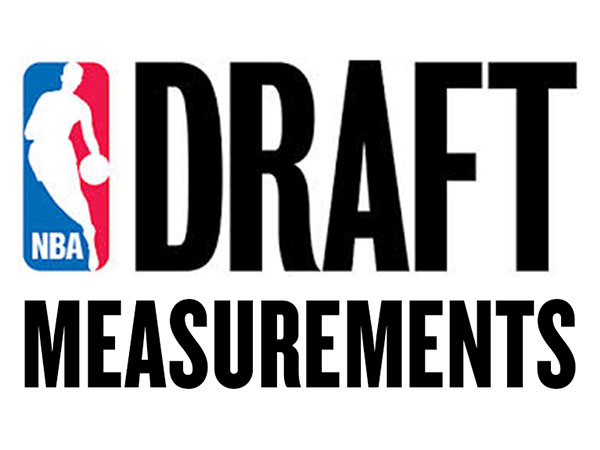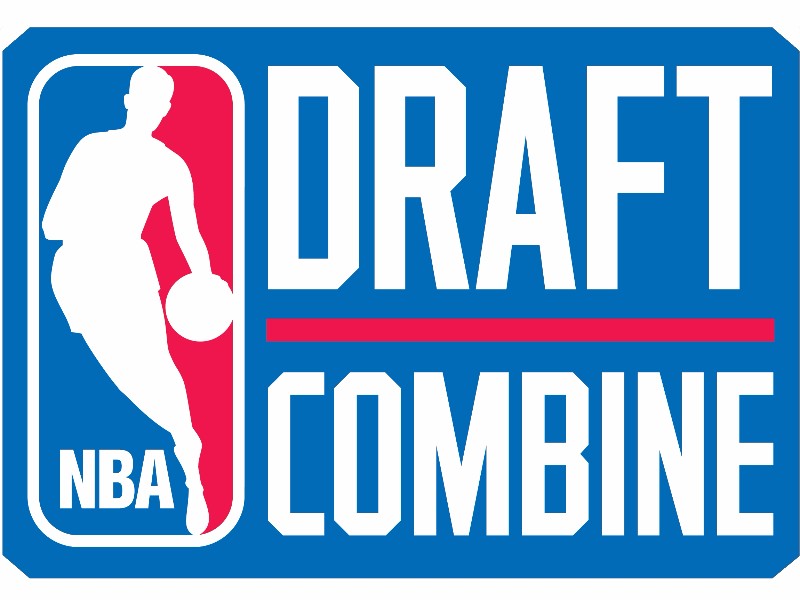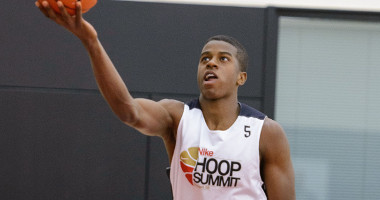The NBA released the athletic testing results from the 2015 NBA Combine in Chicago. We take a look at who stood out and who struggled on paper.
See how all players stack up in DraftExpress' sortable historical measurements and athletic testing database
Though the conclusions that we can draw from the vast majority of the athletic testing data is extremely limited, we'll nonetheless try to take something away from the information we've been presented with.
Trying to pinpoint a player's athleticism based on their combine testing is akin to trying to get a feel for their basketball IQ by watching them play one-on-zero it simply doesn't make all that much sense. It does help us get a very general idea of where a player is at in terms of physical conditioning and strength, which often speaks to their work ethic, but rarely sheds much light on what it really aims to portray.
Unlike the NFL combine, all parties involved realize that few people put much stock in these results. Players aren't trained in running 40-yard dashes from their days in high school like most gridiron stars and simply aren't well versed in many of these tests. Raw athletic data can be useful in a football setting where certain properties manifest themselves more completely on the field, but for the NBA's purposes, a player's lane agility time ultimately and has repeatedly proven to mean very little.
In basketball, where anticipation and coordination play major roles in how players perform on the court, combine numbers will always take a back seat to how a player uses the tools it aims to measure in actual games. Additionally, it's well accepted that there's a learning curve involved: prospects that conduct these tests multiple times will test better than those who are encountering this process for the very first time. Scouts have done their homework, they have a good feel for who the fastest players in the draft are, and know which athletes are the most explosive as it related to what they offer in game-settings. The combine only provides them with a standardized metric for particular athletic traits that often fail to live up to and remain consistent with what they already know.
Despite our reservations about the data, it still exposes some players who land at the extremes of each test, and gives us the chance to draw from some historical perspective on certain marks. At the end of the day though, the numbers these players posted at the combine are only as valuable as their ability to use them on the floor, and no matter how many times a player runs or jumps beyond his perceived means on test day, if he doesn't play to his numbers in games, he's not going to magically change his ways at the next level.
Athletic Testing Composite Rankings
Out of curiosity more than anything else, we've compiled our own Athletic Testing composite rankings. These were made by assigning players points depending on where they graded out compared with the other prospects in each of the tests done in Chicago. In a perfect world, this composite ranking would tell us who the best and worst athletes are in this draft class. Unfortunately, it's far from perfect for the reasons we described above.
-Rondae Hollis-Jefferson performed up to expectations posting a solid maximum vertical leap of 38 inches while posting the 2nd best time in the ¾ court sprint and the 3rd fastest time in the lane agility drill. Often lauded for his potential to guard multiple positions at the next level, the Arizona-product proved that the attributes that give him that potential translate nicely to this setting.
-Kelly Oubre wasn't able to keep up with Hollis-Jefferson in the speed and agility drills ranking right around the middle of the pack. He did however post a terrific 34.5 no step vertical leap, the 6th highest mark of any player in attendance here.
-Justin Anderson was the most impressive performer among the three highly touted college wing prospects. His no step vertical jump of 38 inches is the 5th highest in the history of our database while his 43 inch vertical places him in the top-10. Anderson tips the scales at 231 pounds, the next highest maximum vertical leap for a player weighing over 230 was a 41.5 jump by Alex Poythress at Kentucky's combine earlier this season, a much more unofficial setting. Anderson was also terrific in the shuttle run posting the 5th fastest time and showcased his tremendous combination of strength and explosiveness in this setting.
-Devin Booker posted the fastest lane agility time and shuttle run. Both of his vertical jump marks were below average relative to this year's group standard, but for a player maligned at times for his lack of elite quickness, the 18-year old tested out exceptionally well. Interestingly, his standing vertical leap of 27.5 inches is 4.5 inches short of the mark he set at the UK Pro Day last fall. As we noted, there can be a huge variance in how players perform in many of these tests.
-Like Booker, Wisconsin's Sam Dekker performed well in the quickness drills, but wasn't particularly impressive in the vertical jump testing. He turned in his best finish in the lane agility drill finishing 6th with a time of 11.12 seconds.
-Much like Dekker, R.J. Hunter excelled in one drill, the shuttle run where he finished 6th, but unsurprisingly struggled in the vertical leap testing.
-Terry Rozier was one of the top overall performers finishing 3rd in the shuttle run and 4th in the ¾ court sprint. He finished no worse than 14th in any of the tests posting solid marks across the board.
-Like Rozier, Norman Powell was terrific across the board, except in the shuttle run. His 40.5 inch maximum vertical leap is a reminder that he's one of the most powerful athletes among guards in this draft.
-Cameron Payne wasn't quite as good as Powell or Rozier, finishing above average, but not elite, in any one category. That matches the scouting report on the shifty scoring guard.
-Chasson Randle and Marcus Thornton deserve mention as the top two athletes in this group in terms of our composite ranking. Thornton's ¾ court sprint time of 3.02 is one of the 10 fastest marks posted at any event in the history of our database. The William & Mary product also posted a fantastic 43 inch maximum vertical leap which would rank in the top 25. Randle didn't take the top spot in a single event, but also didn't finish any worse than 10th.
Maximum Vertical Jump
Five Best
Pat Connaughton 44
Keifer Sykes 43
Marcus Thornton 43
Justin Anderson 43
Ryan Boatright 41
Five Worst
Terran Petteway 31
Jonathan Holmes 31
Delon Wright 31
Quinn Cook 31
TaShawn Thomas 30.5
Tyler Harvey 28.5
Alan Williams 28.5
Dakari Johnson 25
Pat Connaughton posted the highest vertical leap of any player in attendance. However, at 6'4 with a 6'8.75 wingspan, Connaughton's maximum vertical reach, or the highest mark he was able to touch during the test, was only 11'8, a full half inch less than that of Marcus Thornton who stands just 6'1.75 with a 6'7.75 wingspan and posted a lower vertical. The sounds suspicious.
Digging deeper, the math behind Connaughton's big maximum vertical leap mark stems from his tiny 8 foot standing reach, which is unrealistically low for a player his height. A player's maximum vertical is calculated at the combine by taking the players maximum vertical reach and subtracting their standing reach. For reference, Thornton, who is much shorter in terms of both height and wingspan, posted a standing reach of 8'1.5. There's no question that Connaughton is a tremendous athlete, but his standing reach was either measured improperly or he followed in the footsteps of a number of players we've seen at the combine in the past and sand-bagged the reach test to pad his vertical. Considering Connaughton posted a standing reach of 8'3.5, which sounds a lot more reasonable, at the Portsmouth Invitational Tournament, his mark has to be taken with a grain of salt. Even if we used his Portsmouth standing reach, he'd still have finished in the top-5, an impressive mark either way, just simply not as eye-popping a figure.
The diminutive Keifer Sykes showcased his incredible explosiveness taking the 2nd spot here. Like Jahii Carson last year, Sykes is a sub-6 foot guard who nonetheless can make explosive plays above the rim. Marcus Thornton and Justin Anderson, both of whom we mentioned about, round out the top-4. All three players rank among the top-15 performers in this test in our database all-time.
Ryan Boatright unsurprisingly takes the final spot in the top-5 just ahead of Norman Powell and Joseph Young. Boatright's made his fair share of spectacular plays in transition over the course of his career at UConn and his explosive leaping ability a first step are a key part of his value proposition at the next level.
The heaviest players in this group, Alan Williams and Dakari Johnson unsurprisingly take the bottom-2 spots here. Tyler Harvey is the only guard to jump under 28.5 inches. Known for his prolific jump shooting ability at Eastern Washington, Harvey wasn't expected to post big numbers here, but teams likely hoped to see him post a higher mark.
Johnson's leap of 25 inches was one of the 20 worst marks in our database all-time, ranking below even that of DraftExpress founder Jonathan Givony.
Larry Nance had the highest maximum vertical reach touching a mark 12'1.5 off the ground. That places him in the same conversation as players like Marcin Gortat and Derrick Favors in terms of elevation. While few discuss max-vert reach as a figure of importance in the Combine setting, it may actually be more important than most others in terms of basketball importance. Chris Walker was just half an inch behind, while Justin Anderson, Richaun Holmes and Michael Qualls came in an inch and a half below. It is especially impressive to see wings like Anderson and Qualls get up that high.
Standing Vertical Jump
Five Best
Justin Anderson 38
Pat Connaughton 37.5
Marcus Thornton 34.5
Joseph Young 34.5
J.P. Tokoto 34.5
Kelly Oubre 34.5
Five Worst
Bobby Portis 25
Terran Petteway 25
Mouhammadou Jaiteh 24.5
Quinn Cook 24.5
Michael Frazier II 24
Dakari Johnson 22.5
Justin Anderson takes the top spot here with, as we mentioned above, one of the top 5 marks all-time. The Virginia product has always been a physically mature, explosive player, but this season saw him emerged as a prolific shooter before his season was derailed by a finger injury. Pat Connaughton takes the 2nd spot, but this test would also be impacted by his suspect standing reach measurement.
Marcus Thornton joined Joseph Young and J.P. Tokoto, both of whom finished just outside of the top-5 in the maximum vertical reach test in the 2nd tier of players. Tokoto is one of the most explosive wings in this draft. Potential top-10 pick Kelly Oubre makes his only top-5 appearance here.
Though Johnson is the low man once again, he doesn't rank historically low. The young big man has some room to improve his frame, and it will be interesting to see what additional lower body strength does for his explosiveness down the road. Michael Frazier and Quinn Cook take the bottom spots among guards. Frazier jumped 11 inches higher in the maximum vertical test than he did in the no-step tests. Cook was among the least explosive guards in both and his excellent efficiency from the shooting guard spot this season didn't have much to do with his ability to play above the rim.
Bobby Portis didn't test particularly well across the board, and makes his first bottom-5 appearance here.
Richaun Holmes had the highest no step vertical reach touching a mark 11'8.5 off the ground, tying him with a young Amare' Stoudemire for one of the 50 or so best marks all-time. He actually posted a slightly better mark at the PIT (11'10) last month. Rakeem Christmas was second here with 11'7.5.
Lane Agility Drill
Five Best
Devin Booker 10.22
Keifer Sykes 10.5
Rondae Hollis-Jefferson 10.51
Tyler Harvey 10.52
Chasson Randle 10.61
Five Worst
Michael Qualls 11.88
Tyus Jones 11.89
Mouhammadou Jaiteh 12.05
Alan Williams 12.07
Branden Dawson 12.37
The lane agility drill has players running, shuffling, and backpedaling around the perimeter of the key until they reach the corner they started in and then follow their path back around the same path in the opposite direction. Devin Booker posts a fantastic time here, ranking among the better marks in the last 10 years. Booker isn't known for his quickness, but he stayed low while running this test extremely hard and intelligently, and it paid off placing him in a tier by himself.
Sykes, Hollis-Jefferson, and Randle all ranked among the top overall performers in the athletic testing portion of this year's combine. While Sykes and Randle are no lock to be drafted, they seized this opportunity to showcase their athleticism. Tyler Harvey is a bit of a surprise here considering his poor marks in the vertical jump testing, but the talented guard showed the ability to create separation from the perimeter this season, and that appears to have translated here.
This test tends to get the best of a few excellent athletes this year and Michael Qualls and Branden Dawson are the players in the bottom-5 that may not have kept their balance well enough or taken one bad step en route to surprisingly poor performances. Williams and Jaiteh are two of the more bruising big men in this draft, so it follows that they'd have a hard time changing directions over short distances.
Tyus Jones has often been maligned for his athletic ability, and his below average overall testing seems to corroborate that part of his scouting report. The question is just how far Jones's outstanding skill level will offset his less than stellar physical attributes.
Shuttle Run
Five Best
Devin Booker 2.75
Chasson Randle 2.81
Terry Rozier 2.84
Marcus Thornton 2.88
Justin Anderson 2.88
Five Worst
Quinn Cook 3.41
Chris Walker 3.41
Delon Wright 3.5
Branden Dawson 3.53
Alan Williams 3.54
Devin Booker takes the top spot here, along with the usual suspects. Anderson is the outlier in that group as easily the heaviest of the 5.
Branden Dawson's surprising string of poor testing continues here, as does Quinn Cook. Both players had terrific moments scoring in transition this season despite their less than stellar athletic testing. Alan Williams is the logical low-man here. Delon Wright is the surprise as he graded out right around average in almost every other test. Chris Walker rounds out the bottom-5. His best mark came in the maximum vertical jump test where he registered a leap of 37 inches.
3/4 Court Sprint
Five Best
Marcus Thornton 3.02
Rondae Hollis-Jefferson 3.12
Keifer Sykes 3.13
Terry Rozier 3.15
Anthony Brown 3.18
Five Worst
Jonathan Holmes 3.51
Corey Hawkins 3.51
Bobby Portis 3.56
Brandon Ashley 3.58
Dakari Johnson 3.62
Marcus Thornton, perhaps the least well-known player in attendance at this year's combine, takes the top spot here. He was tremendous across the board, but his 3.02 dash is one of the top-10 all-time placing him ahead of Derrick Rose and Speedy Claxton. Hollis-Jefferson and Anthony Brown weren't quite as outrageously fast, but for wings, both players posted terrific times. Keifer Sykes and Terry Rozier were two of the more shifty guards in the college game last year, so it comes as no surprise to see them round out the top-5.
Dakari Johnson and Bobby Portis are both in the 6'10/250 ballpark, so it makes sense that they both struggled in this test. Neither player's time is even close to being historically bad. Hawkins is the only guard in the bottom-5.
2015 NBA Combine Athletic Testing Analysis

May 15, 2015, 10:57 pm
Read Next...
-
NBA Combine Competitive Action Recap: Day One
May 11, 2017, 08:04 pmRecapping the six most impressive performances from day one of the competitive action at the NBA Combine, including Kyle Kuzma, Frank Mason, Rawle Alkins, Jordan Bell, Tyler Dorsey and Frank Jackson. -
2017 NBA Draft Combine Measurements Analysis
May 11, 2017, 02:49 pmThe measurements taken at the NBA Combine in Chicago, Illinois were released today.
Recent articles
7.3
Points
2.0
Rebounds
2.0
Assists
9.2
PER
10.2
Points
2.6
Rebounds
2.7
Assists
14.1
PER










































































Comments